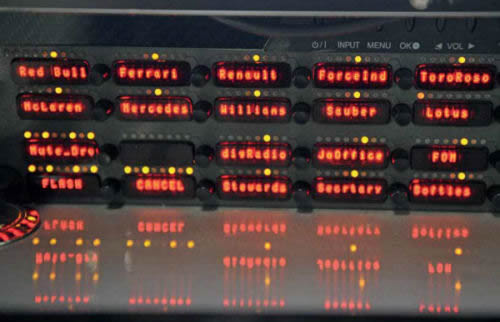Race control
Race control is at the heart of Formula 1 races. Race control is responsible for monitoring and supervising the practice sessions, the qualifying sessions and the race itself. The stewards are charged with assessing on track misdemeanours and punishing drivers accordingly. Facilities vary between different circuits, but all will have several key features essential to allowing the FIA Race Director and his staff to make the right decisions to keep things safe, legal and to schedule.
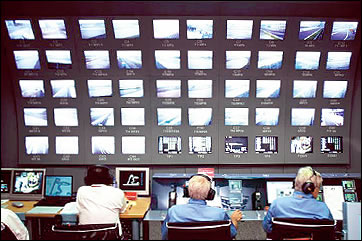
Race control has screens which show all parts of the circuit so that problems can be flagged quickly and dealt with.
While the identity of the entire group of people working in race control is usually unknown – and even if it is, those name would most likely not ring a bell to anyone – they are all headed by the FIA's race director Charlie Whiting. Whiting's first job with the FIA was as a technical delegate. In 1997, the Brit was appointed new Race Director of the FIA, while also being named Safety Delegate.
The FIA race director Charlie Whiting and three race stewards, plus, from 2010 one ex race driver as consultant, make sure the race is safe, legal and on schedule. To do so, the race control unit make use of CCTV (closed circuit television system) and car onboard cameras to locate problems and take action quickly.
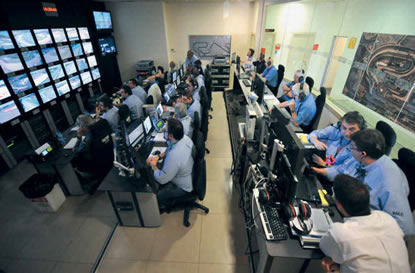 |
Race Director Charlie Whiting and his deputy Herbie Blash (top left) take an overview of the action in Barcelona, while a team of FIA experts and local circuit officials examine specific areas of the event. |
Additional information is accessible by the FIA race director. He will have access to data such as the pit lane speed trap, contact with relevant personnel about marshal posts, safety car, medical response car and the medical centre. Deployment of the safety car and other important instructions are under the responsibility of the race control unit.
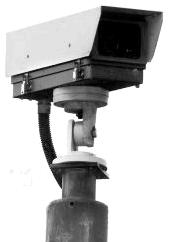
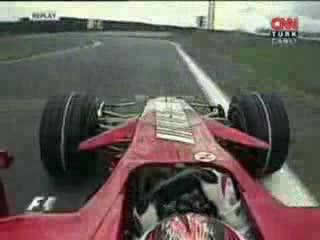
When a driver breaks rules or sporting code of racing, it is the duty of the race control unit to discipline the drivers.
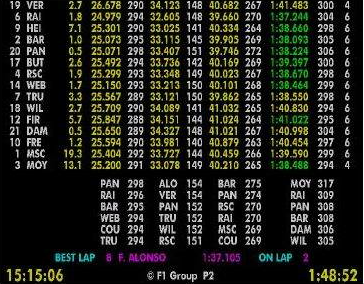
They have a timing data feed that they can watch - this is the same feed that is given to the teams. They will also have access to other racing information so that they can check that all cars are running a fair race and adhering to all the FIA's rules and regulations.
Race control are in constant contact with the teams, principal marshals, the safety car, the medical response car and the medical centre, both via telephone and radio. This means that if any major unexpected event occurs, the Race Director can deploy any one of these safety teams to the scene quickly and safely.
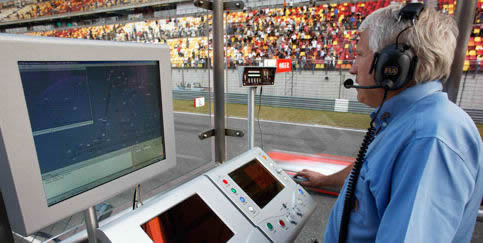
Charly Whiting, race director
The Race Director has a whole support team behind him - both FIA personnel and local circuit personnel. Race control have the responsibility for ensuring all driver's abide by the rules and they will punish any drivers who break these rules - the most common punishment is a 'drive-through' where the drivers have to drive through the pit-lane instead of going down the main straight, or "Stop and Go"where a driver have to enter pit lane, stop for 10 seconds and then continue the race. For more complex disciplinary issues such as someone causing an accident, the penalties will be decided at the end of the race to give teams chance to review footage and to defend their drivers.
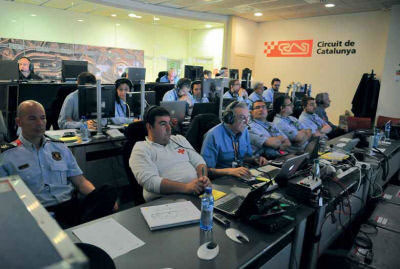 |
Race Control is a remarkably calm environment during a race. At the back of the room is FIA desk is manned by Whiting and people. In front sits officials from medical staff to technical and communications specialists. The control room is also in contact with the teams and drivers at all times and monitors radio traffic between the pit wall and the cars throughout each session. All the data is recorded for future reference should the need arise during a post-event investigation. |
The racing past comes to play when race control has to react on something that happened on the track (from a sporting point of view). Now, bear in mind the fact that each and every steward of an F1 race knows by heart every paragraph of the sporting regulations.
However, there is this old, never-ending dilemma that constantly attaches itself to every decision making process since the term “law” was invented: do you judge by the letter of the law, or in the spirit of the law?
For many years, the F1 stewards, with the FIA’s boss of stewards Gary Connelly as the leading person, used to make title-impact decisions by simply obeying the law, without taking into account the sporting element of the equation. To solve that problem, the FIA has now, from 2010, appointed a former racing driver to assist when sporting decisions are made, in order for the decision to be correct from all angles. However, it's not the same person who takes that role race in and race out, but a different ex-racer.
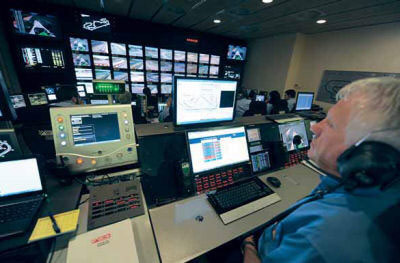 |
|
If a serious event happens or if the conditions become too poor to race, the Race Director is able to stop the race.
All traffic light systems (red-green in pit lane, flag warning system) are programmed and controlled from the Race Control Centre. The emergency doctor also receives his order to go into action from here when required. In addition to images of the racetrack and data for time measurement, all information on the power supply, air-conditioning system, the heating and ventilation system, fire alarm system and access control runs in parallel into the Building Management Control Room, where it is permanently monitored.
A racetrack requires its own internal communication system so that communication between the different organizational and event units functions smoothly and, above all, reliably. This is the job of the SMATV (Satellite Master Antenna Television), a type of internal broadband information system that transmits pictures and sound. Last but not least, the marshal intercom system guarantees that the information exchange between marshals and the Race Control Management Centre runs smoothly.
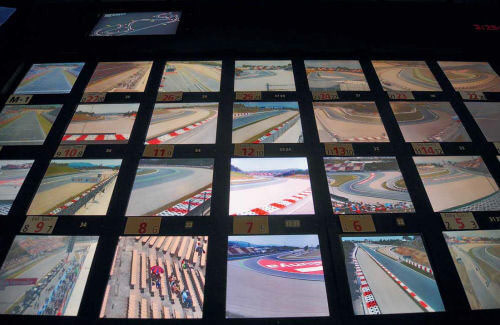 |
There are up to 45 television screens in Race Control, each displaying a different angle of the on track action. Each is carefully monitored by the staff at each circuit. All communication is done via headsets and the room has a definite feel of 'Mission Control'. Main points on the track are examined in Race Control which then sends reports of any incidents that need to be evaluated to the stewards in a nearby room. |
In Formula One, the focus of the technological arms race is always the cars. But behind the scenes, the sport continues to push technological boundaries across a range of fields. In the Race Control tower, the FIA uses an arsenal of technology to help Stewards detect and review incidents on track, in real time. There are only few suppliers capable of delivering such sophisticated control system. One of them is Siemens.
Siemens installed the complete race control management, security, data-exchange and communications infrastructure at the Bahrain race track. The 5.4 km track in the middle of the desert boasts a race management system, a GPS synchronized timekeeping and signalling system, and digital video recording and PA systems. Track managers have access to 45 signal lamps and nearly 1,000 loudspeakers. Thirty-six remote-controlled CCTV cameras monitor action on the course. Smooth communication is guaranteed by a 550 km fibre-optic network equipped with gigabit Ethernet technology and backed by a digital communications system.
A STATE-OF THE-ART SOFTWARE SYSTEM IS HELPING THE FIA TO IMPROVE SAFETY AND MAKE MORE RAPID DECISIONS DURING FORMULA ONE GRANDS PRIX. ON THE PICTURE DIRECT RADIO CONECTION WITH EVERY TEAM IN THE PADOCK |
Here is how stewards get to the decision in case of incidents. FIA’s deputy President of the FIA Institute and a regular Chair of the Stewards Gary Connelly explains:
“First of all, we have all the video feeds — the pictures that have gone to air; the vision captured by FOM Communication TV system but which hasn’t been put to air; the closed circuit cameras around the track, and all the onboard material as well,” he says. “We have GPS tracking, which shows where cars are at any given time."
“We also have access to all the team radio transmissions, which are very important as they allow us to know if a team has warned a driver that he’s about to impede another car and whether a driver has ignored that information. Finally, as of this summer (2012), we can now obtain real-time telemetry from the cars. That’s really useful as we can overlay telemetry information from an incident with data from previous laps, so for example, we can tell if a driver has done something like failing to back of under yellow flags. The system is programmed to highlight any incident — for example, if a driver goes too quickly in a section under yellow flags. That’s based on GPS tracking and timing, but the software also has a number of other inputs and is programmed to respond accordingly."
“Linking all this together you can come up with a complete picture of what’s going on. You have a mass of information that isn’t available to the public or the teams. That’s why decisions are sometimes taken that people have trouble understanding, but they simply don’t have all the information the Stewards do.”
FIA Race Director Charlie Whiting adds that in an effort to ensure consistency of decisions, all the incidents from recent seasons are kept on hard drives so that stewards can refer to them with repeat offenders or refer to precedents when deciding on penalties. “It’s an invaluable resource because, of course, the same Stewards are not at every race. This way they can refer back to all that past footage and it helps them make a more informed and consistent decision."
Back to the top of the page

